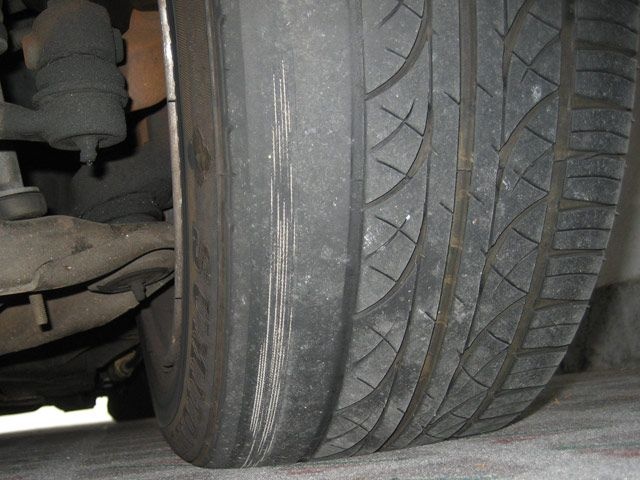Irregular tire wear is a frustrating little gremlin that can steal your tires’ performance and tread life if you let it. The problem is that irregular wear comes in so many different flavors. The causes of strange tire wear can range from air pressure to improper balance, from misalignment to bent wheels. Here’s how to recognize the problem, how to tell where it’s coming from and what to do about it.
Causes:
Air Pressure: Improper air pressure will cause tires to wear in specific patterns according to whether the tire is over-pressured or under-pressured.
Balance Issues: Improper balance will cause the tire to spin with a wobble due to unbalanced centrifugal forces. This wobble will cause the tire to wear improperly and probably show up as a vibration as well.
Bent Wheels: A bent wheel, in addition to probably causing a vibration in the car, will also affect the wear on its tire and can even affect the wear on the other tires as well. As the bead of the tire follows the contour of the wheel, the bend in wheel will be mirrored by the tire’s shoulder tread as the whole sidewall dips to follow the bend. This can cause all kinds of strange wear.
Alignment: A 4-point alignment (as opposed to a front-end alignment) essentially ensures that the tires are all parallel to each other and flat to the pavement, giving the tires their optimal wear profile. If the alignment is incorrect, any number of wear patterns can develop. Additionally, the kind of impact that will bend a wheel will generally also knock the alignment out, creating a tire wear situation that basically feeds on itself.
Wear Patterns:
One Shoulder: If only one of the shoulders is excessively worn, the cause is generally alignment, specifically incorrect camber. The tire is tilted to one side or the other and putting too much pressure on the shoulder. By the time this kind of wear becomes obvious, it can often be too late for any remedy short of replacing the tire and then realigning, although sometimes the tire can be rotated to the opposite side or flipped on the wheel.
Scalloping/Feathering: Scalloping, which some techs call feathering, is when all the tread blocks on one shoulder develop a wear pattern in which one block edge is higher than the other, leaving a set of raised edges on the leading or trailing edge of each block. Running your fingers lightly along the tread blocks produces an unmistakable “flutter” as you brush over the raised edges. The earliest sign of this kind of wear is often an unpleasant change in the noise the tire produces – the high hum of the “tire song” often changes to a loud growl as the edges strike pavement. This is generally caused by incorrect camber, and can be thought of as pretty much the larval stage of the one shoulder wear described above – it’s just possible that you’ve caught it early enough that if you correct the alignment, the tire just might “wear back in” to a more normal pattern over time. Scalloping is often indirectly caused by an impact that knocks the alignment out.
Both Shoulders: If the tire is worn on both shoulders, the cause is underinflation. The manufacturer’s recommended pressure is usually on a plaque riveted to the inside of the driver’s door.
Center Rib: If the tires are worn more in the center, this is usually due to overinflation. Make sure your tire pressure is set to the manufacturer’s recommended pressure rather than the pressure embossed on the tire’s sidewall. The pressure on the sidewall is a maximum safe pressure, not a recommendation. If pressure is not the issue, it may be that your tires are too wide for the wheels.
Spot Shoulder: If one of the shoulders is excessively worn in only one spot, this is almost certainly due to a bent wheel or a bent steel belt inside the tire.
Lateral Wear: Lateral wear causes the tire to wobble from side to side as it spins. This is almost always an alignment issue, specifically an incorrect toe setting. “Toe” is the degree to which the tires are not parallel to the direction of the car. A wheel that is “toed-in” is slanted towards the car, while a “toed-out” wheel slants away. The classic toe issue is the one that has both front tires toed to the same direction, which will cause the car to pull towards one side or the other when you let go of the wheel in the age-old, do-I-need-an-alignment test. But there is also an issue when two opposite tires are either both toed-in or both toed-out. This will not cause the car to pull appreciably, because both tires are now fighting each other, putting lateral pressure on each other, and possibly creating a tremendously annoying kind of juddering vibration in the car. This kind of wear can occur surprisingly fast, but if caught quickly enough can wear back in very fast as well once the alignment is corrected.
As always with tires and wheels, an ounce of prevention can be worth a pound of cure. The best preventatives for odd tire wear are really fairly simple; monitor your air pressures, align the car whenever new tires go on and rotate the tires regularly.

Irregular Tire Wear: Causes, Indicators and Remedies
by
Tags:

Leave a Reply